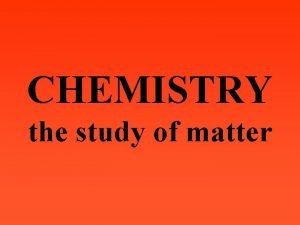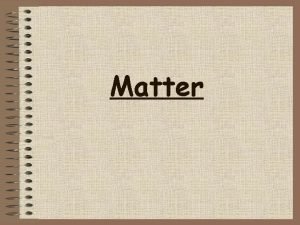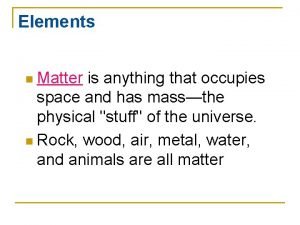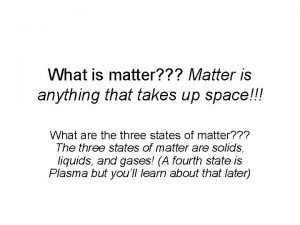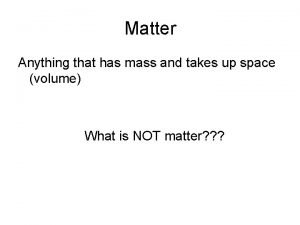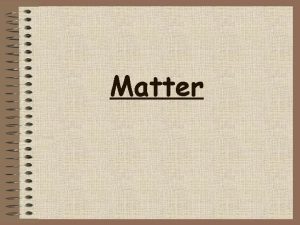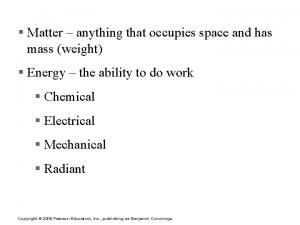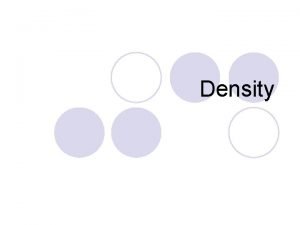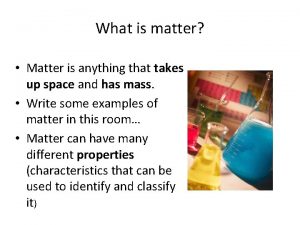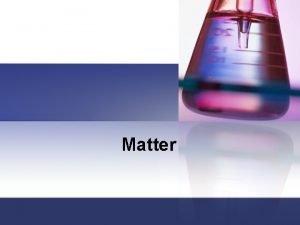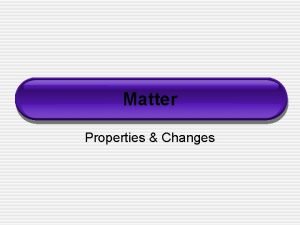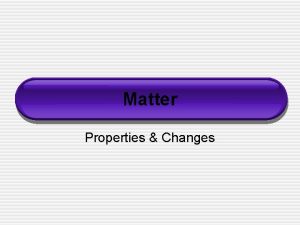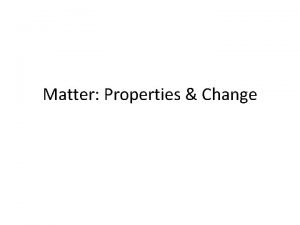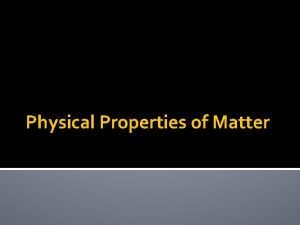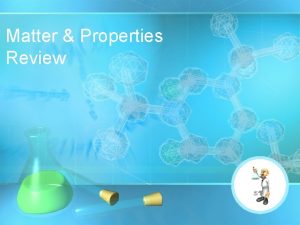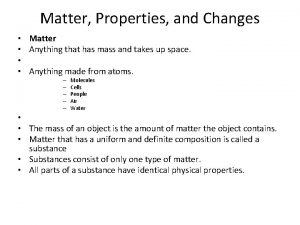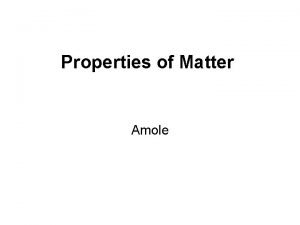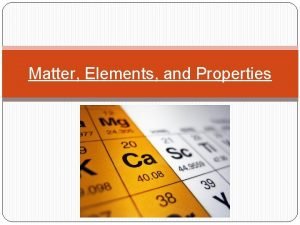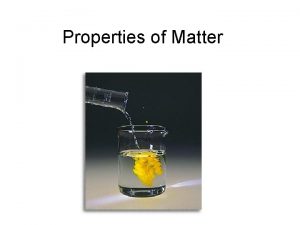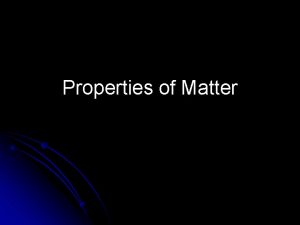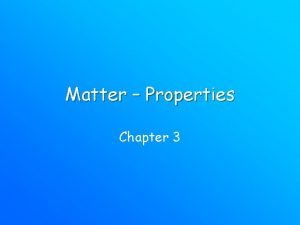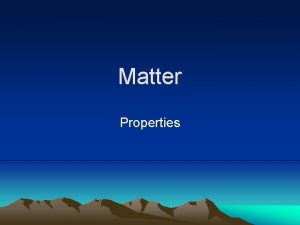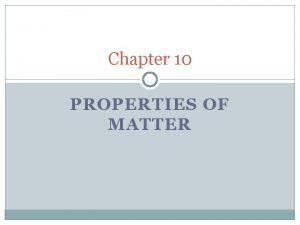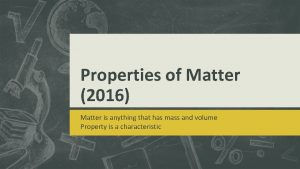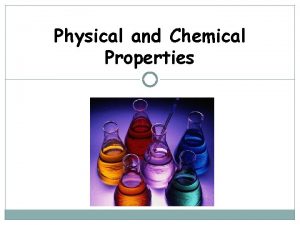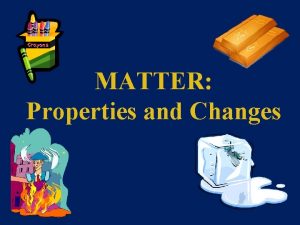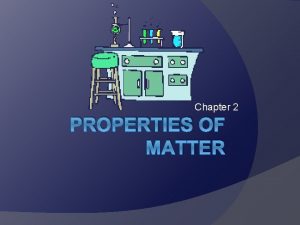Properties of Matter Matter Matter is anything that



























- Slides: 27

Properties of Matter

Matter • Matter is anything that has mass and takes up space. See excerpt from Bill Bryson • Everything around you is made of matter. • Can matter change? If yes, how?


Properties of Matter • A Property is a characteristic used to describe something. • There are two types of properties we will learn about – physical properties and chemical properties.

Physical Properties of Matter • A Physical Property is a characteristic of a substance that can be observed and used to describe it. • Physical Properties describe a substance as is. It does not involve the substance changing what it is. • Some examples: o Color – red, yellow… o Texture – rough, smooth…. o Taste – sour, salty. sweet….

List some physical properties from the image below:

Sample Responses • • Color – Brown Smell – like coffee Texture – smooth Size – small

Other Physical Properties of Matter • 1. State: solid, liquid or gas – usually given for the substance at room temperature

2. Hardness: the measure of the resistance of a solid to being scratched or dented o A harder material will scratch or dent a softer one

Mohs Scale of Hardness

3. Malleability: The ability of a substance to be hammered or bent into different shapes. Examples: • Aluminum foil and Gold are malleable. • Glass is not malleable. • The opposite of malleable is brittle (shatters when hammered instead of flattening out)

Malleability

4. Ductility: The ability of a substance to be pulled out into wires • Copper is ductile

5. Melting and Boiling Point: The temperature at which substances change state. • Melting point of water (change from solid to liquid) is 0°C • Boiling point of water (change from liquid to vapour) is 100°C

Melting Boiling

6. Crystal Form: A solid form in which you can see a definite structure of cubes or blocks with a regular pattern • Example: salt quartz

7. Solubility: The ability of a substance to dissolve in a substance such as water. • Salt is soluble in water • Pepper is insoluble in water (insoluble means not soluble)

Sugar Dissolves in Hot Coffee

8. Viscosity: refers to how easily a liquid flows • The thicker the liquid – the more viscous it is • Molasses is more viscous that water

9. Density: The amount of matter per unit volume of that matter • Measured in g/cm 3 • The density of water is 1. 0 g/cm 3

Anything that is less dense than water will float in water. Anything that is more dense than water will sink in water.


Chemical Properties of Matter Chemical Properties describe the behavior of a substance as it becomes a new substance. 1. Combustibility: (or flammability), is the ability of a substance to burn. • Combustion is the reaction of a substance with oxygen to produce water vapour, carbon dioxide and energy. • Wood and gasoline are flammable/combustible • Water is not flammable/combustible


2. Reaction with Acid: when exposed to acid, will the substance react with it? • When magnesium reacts with acid it produces bubbles and eventually disappears. • When gold is exposed to acid, we see no change. • Geologists use acid to test samples of rock for specific minerals.

Magnesium reacts with acid to produce hydrogen gas bubbles

Another Way to Classify Matter • Matter can also be classified as Metals and Nonmetals • Mixtures of metals are called Alloys and can make metals more versatile and useful. • Alloys are used for a variety of things and are created for specific uses. Examples are airplane parts, braces for teeth, and cooking pots.
 Phân độ lown
Phân độ lown Chiến lược kinh doanh quốc tế của walmart
Chiến lược kinh doanh quốc tế của walmart Gây tê cơ vuông thắt lưng
Gây tê cơ vuông thắt lưng Block nhĩ thất độ 1
Block nhĩ thất độ 1 Tìm vết của mặt phẳng
Tìm vết của mặt phẳng Sau thất bại ở hồ điển triệt
Sau thất bại ở hồ điển triệt Thể thơ truyền thống
Thể thơ truyền thống Con hãy đưa tay khi thấy người vấp ngã
Con hãy đưa tay khi thấy người vấp ngã Thơ thất ngôn tứ tuyệt đường luật
Thơ thất ngôn tứ tuyệt đường luật Tôn thất thuyết là ai
Tôn thất thuyết là ai Anything that has mass and volume
Anything that has mass and volume Matter anything that
Matter anything that Anything that has mass
Anything that has mass Matter is anything that occupies space and has -----------
Matter is anything that occupies space and has ----------- Anything that has matter and takes up space
Anything that has matter and takes up space Matter is anything that
Matter is anything that Matter anything that
Matter anything that Matter anything that
Matter anything that Anything that has mass and takes up space
Anything that has mass and takes up space Ionized matter
Ionized matter 7 diatomic elements
7 diatomic elements No matter anything
No matter anything Benjamin cummings
Benjamin cummings Use of density
Use of density Mass and occupies space
Mass and occupies space What is matter
What is matter Matter is anything that has and occupies
Matter is anything that has and occupies Physical properties defintion
Physical properties defintion











